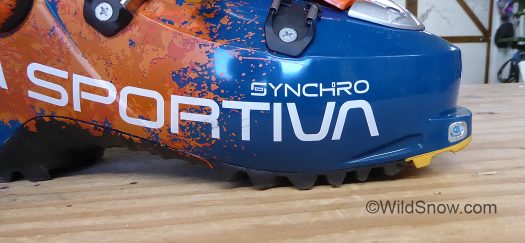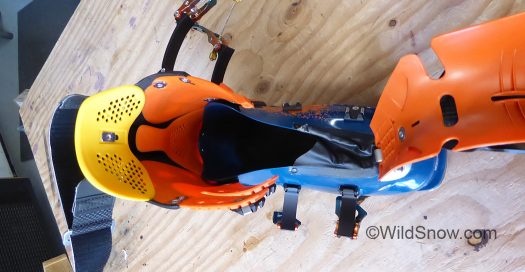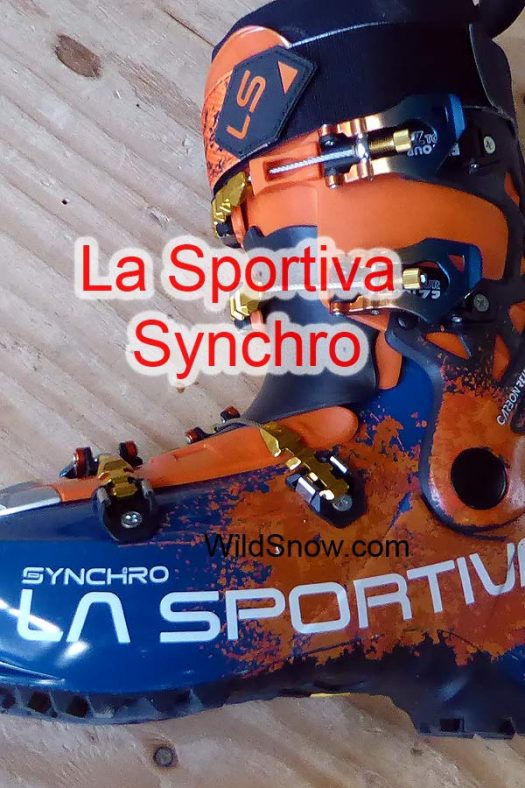After skiing the boot a bit last winter while in Italy, I’ve been eagerly awaiting the retail version Synchro (Shadow in women’s version) so we could do an honest unboxing. This is essentially an upgrade of the now venerable Spectre, boasting a clever two piece tongue that flexes while touring and locks for downhill when buckled tight. Scaffo is still constructed with easily customized Grilamid, cuff latch is said to be improved. Overlap liner instead of the Synchro’s tongue liner. Check out a few photos.
(This post sponsored by our publishing partner Cripple Creek Backcountry. They’re a Sportiva dealer, contact.)

As before, multi-purpose tech fittings are present — functional with classic tech bindings or Trab. The Trab portion of the heel fittings can be removed and trimmed if you’re not on Trab.
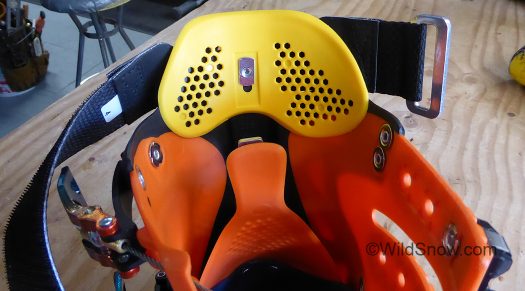
Rear spoiler is asymmetric, as well as being removable. Same as original Spectre as well as Spectre 2. Useful during configuration for folks with large and lower located calf muscles, or wanting a bit less cuff lean. More, this is a boot that can be weight stripped like a drag car; remove spoiler, power strap, lower 4th buckle, and you get an interesting rendition of a beefy boot. Perhaps somewhat physiological in terms of what it really offers, Spoiler only rises one centimeter above cuff rear. Personally, if I’m using a spoiler I’d prefer it rose closer to two or three centimeters.
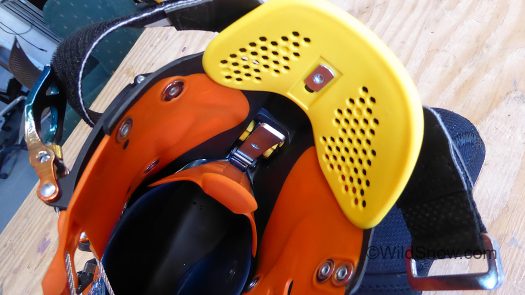
Interior view of lean lock, said to be improved over early Spectre, which did have problems in this area. This rather complex machinery. I see the point of an internal lean lock, but one has to wonder if it would be better for Sportiva to cut bait on this and just mount a lock bar on the outside of the boot, as appears to be the industry trend. Tesla does hidden door latches, but do ski boot designers really have to worry about such things?
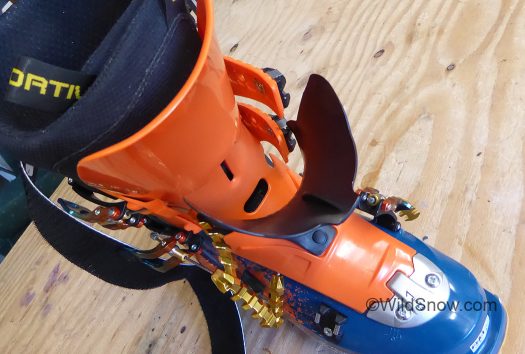
Two part tongue, locking slot and hinge. This the most distinctive improvement over Spectre, a significant gain in lessening forward resistance in uphill mode. Good example of effective design through simplicity. We’ve seen other brands trying this sort of thing, but so far Synchro appears to be the best execution of the concept. Downside is you’ve got to arrange your buckle tension just so in walk mode, or the tongues can sandwich together and catch.
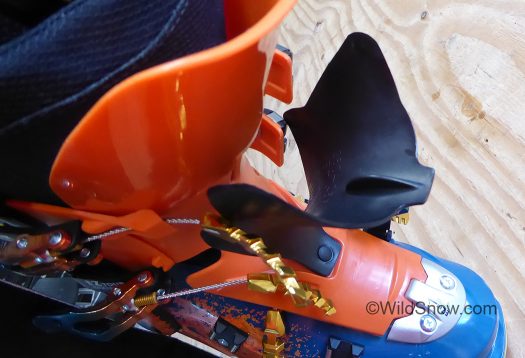
Another view of two part tongue, showing the black ‘nib’ that inserts in main tongue when buckled, adding significant forward strength to the boot flex.
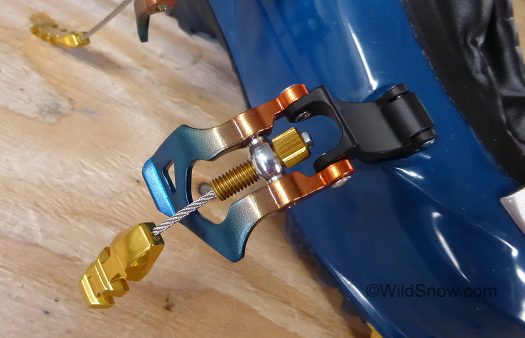
Slightly changed buckles are an interesting version of what Sportiva has offered since Spectre 1, ‘Pegasus Plus Buckle’ micro adjusts using something similar to a bicycle cable tension device. Tolerances on these appear slightly better than the originals, which I trust will do a better job of resisting loosening when they’re lightly buckled for the uphill. Of more importance, note major redesign of the buckle fastener portion, it uses scalloped sides to attach to the boot anchor. See next photo.
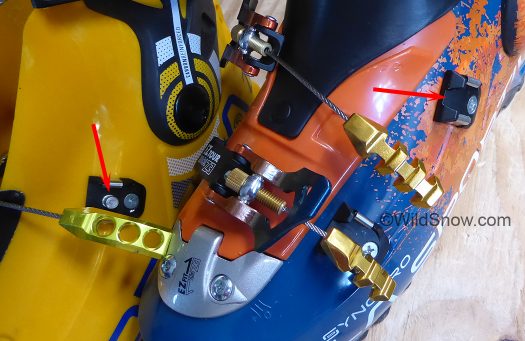
Spectre 2 at left, note the buckle anchors as well as changed buckle shape. I like the Pegasus type buckle, but they do take some getting used to for those who’ve spent decades clipping standard ski boot buckles.
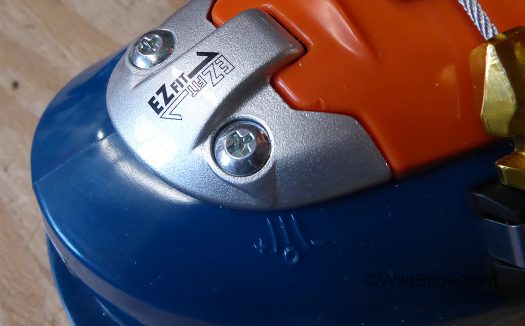
As with Spectre, shell tongue angle is adjustable. Seems useful but probably something most need not fiddle with.
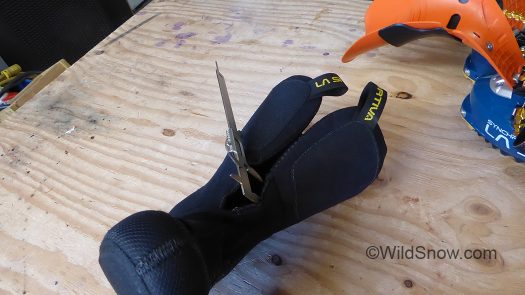
Big change (and the only real distinction from Spectre other than two peice tongue) is the stock overlap liner, thermoformable as you would expect. This won’t tour as well as Spectre, but does add solidity to your downhill ventures. Swapping in an aftermarket tongue type liner would improve Synchro for the uphill, an easy modification.
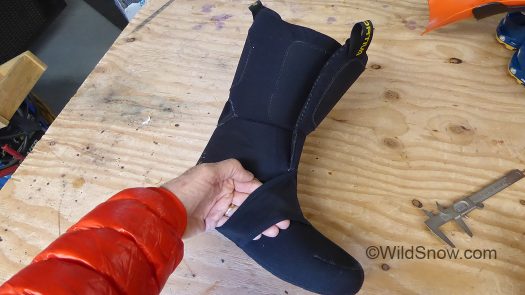
I like this little gadget, band of lycra that helps close the liner overlap correctly, thus avoiding liner damage caused by crunching it together during boot buckling.
Preemptive question and answer: “Lou, can the two piece tongue be swapped to the Spectre?” “Yes, though I have no idea of availability.”
Conclusion:
Beautiful shoes. Two piece shell tongue is the significant difference from Spectre. Overlap liner differentiates as well, but is easily swapped for a tongue liner if you’ve got the need and the cash. Works with Trab binding. Grilamid scaffo is easily heat punched. I did ski a pair of these last winter in Italy. They tour better than you’d expect from a tongue shell combined with overlap cuff, meaning with buckles adjusted properly they’re ok but not exceptional. Swap in a tongue liner and the lack of tongue resistance would cross over more to the exceptional category. Rearward cuff travel is good, but actual rearward ankle freedom is limited by the stiff liner. Synchro is plenty stiff on the downhill, progressive feel of flex was what I’d call average for a tongue shell.
Weights, 27.5 Synchro, BSL 304
Shell, 1244 grams
Liner, 246 grams
Boot complete, 52.6 ounces, 1,490 grams (1550 grams catalog weight)
Compare to Spectre at 51.8 ounces, 1470 (1445 grams catalog weight)
WildSnow.com publisher emeritus and founder Lou (Louis Dawson) has a 50+ years career in climbing, backcountry skiing and ski mountaineering. He was the first person in history to ski down all 54 Colorado 14,000-foot peaks, has authored numerous books about about backcountry skiing, and has skied from the summit of Denali in Alaska, North America’s highest mountain.


